What to eat have become the most important question among today’s travelers. During your stay in Antalya, do not miss out on the richness of Turkish cuisine.
Turkish breakfast: "Kahvaltı"
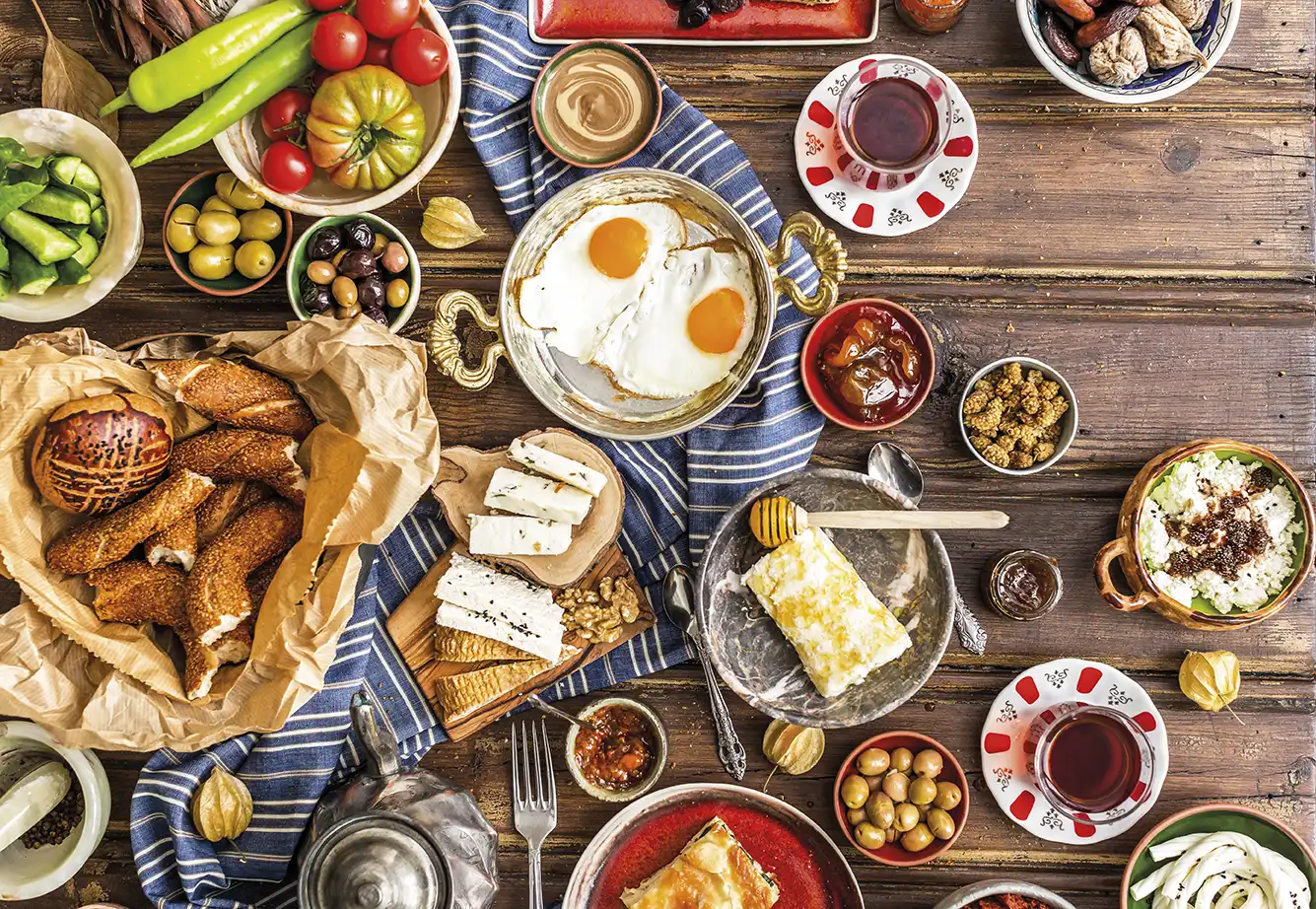
The word ''kahvaltı'' has its origin in “kahve altı” which means “before coffee”. The breakfast comes with a coffee at the end. Turkish breakfast can be divided into two parts:
A plate of tomatoes and cucumbers, a cheese plate, the best known is the white cheese. Honey with cream, grilled sucuk (Turkish chorizo), olives, and jams. Everything is spread on toasted fresh bread, or simit and poğaca, traditional tasty Turkish pieces of bread.
Then comes the main egg dishes served in an individual casserole. There are two main dishes:
Fried Eggs, which can be eaten plain or accompanied by sucuk and cheese.
Menemen, which is scrambled eggs with tomatoes, onions, peppers with optional cheese.
Turkish breakfast is really something not to be missed and there is always something more delicious to eat, such as simit, gozleme, su boregi and Serpme borek.
Simit
Simit is a sesame crusted, circular bread also known as Turkish bagel, This crusty bread is probably the most common bread in Turkey. It's usually served for breakfast and it always has a ring shape. They're sold everywhere, by street vendors carrying baskets or pushing carts, in bakeries and cafes.
Gozleme
Alternatively known as sac boregi, pastry cooked on a sac, a hot convex metal plate, gozleme are flat savory pockets usually filled with salty white cheese, spinach or minced beef.
Although often considered village food, it takes expert handling to roll out the paper-thin dough without tearing it.
Su boregi
Borek, a savory pastry made from layering sheets of a fine filo-like dough called yufka. Su boregi is the most commonly available, relying on white cheese, butter, olive oil and salt for flavor.
Serpme Borek
Serpme borek is a local specialty. In general, borek is a phyllo dough filled pastry that you must try while in Turkey. Antalya’s serpme borek is popular for breakfast and should be made fresh to order, usually with cheese or minced meat inside.
TURKISH Traditional Appetizers: "Meze"
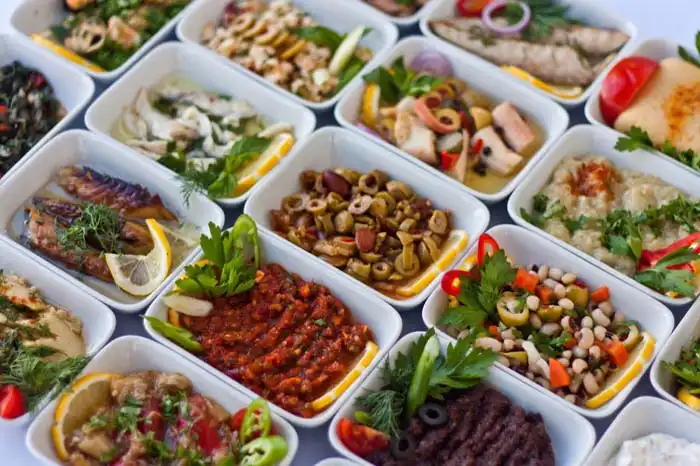
One of the most important dishes of the Turkish cuisine is the "Meze" (appetizer). Turkish meals are usually a social event that can last for several hours especially at dinners or during weekends. Either you serve alcohol or not during meals, it's a tradition to serve and eat rounds of hot and cold starters before the main dish is eaten. There is a huge selection of mezes in the Turkish cuisine therefore usually the table is full of several treats, sometimes they're so much that you're full and don't have any room left to eat a main dish afterwards.
Mezes are always eaten slowly together with drinks, especially with Raki. There is always lots of conversation going around the table with your friends so you spend several hours without noticing. When mezes are served on the table, you take samples from each plate you like and put it on your own plate then you start to taste them. Either you're having a fish dinner or meat dinner, you'll always have mezes first.
Fish Dinner: "Rakı-Balık"
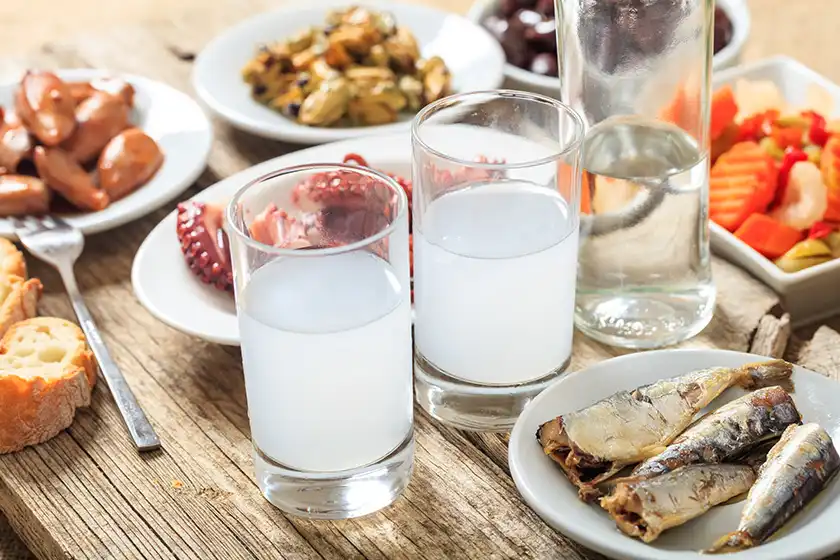
Antalya is full of fish restaurants called “meyhane“.In these establishments, we usually drink rakı (Turkish pastis) while eating mezes as starters, followed by fish. This kind of meal gave birth to an expression “let’s have a rakı-balık” (“rakı-fish”). It is a Turkish tradition, a “rakı-balık” usually lasts for hours, and all topics of conversation are discussed. It’s really a very friendly meal, definitely a must-do during your stay.
The starters consist of cold and then hot mezes. There are so many sorts of them that the easiest way to know what you want to eat is to ask for the presentation tray of mezes.
Meat Dinner: "Kebap"
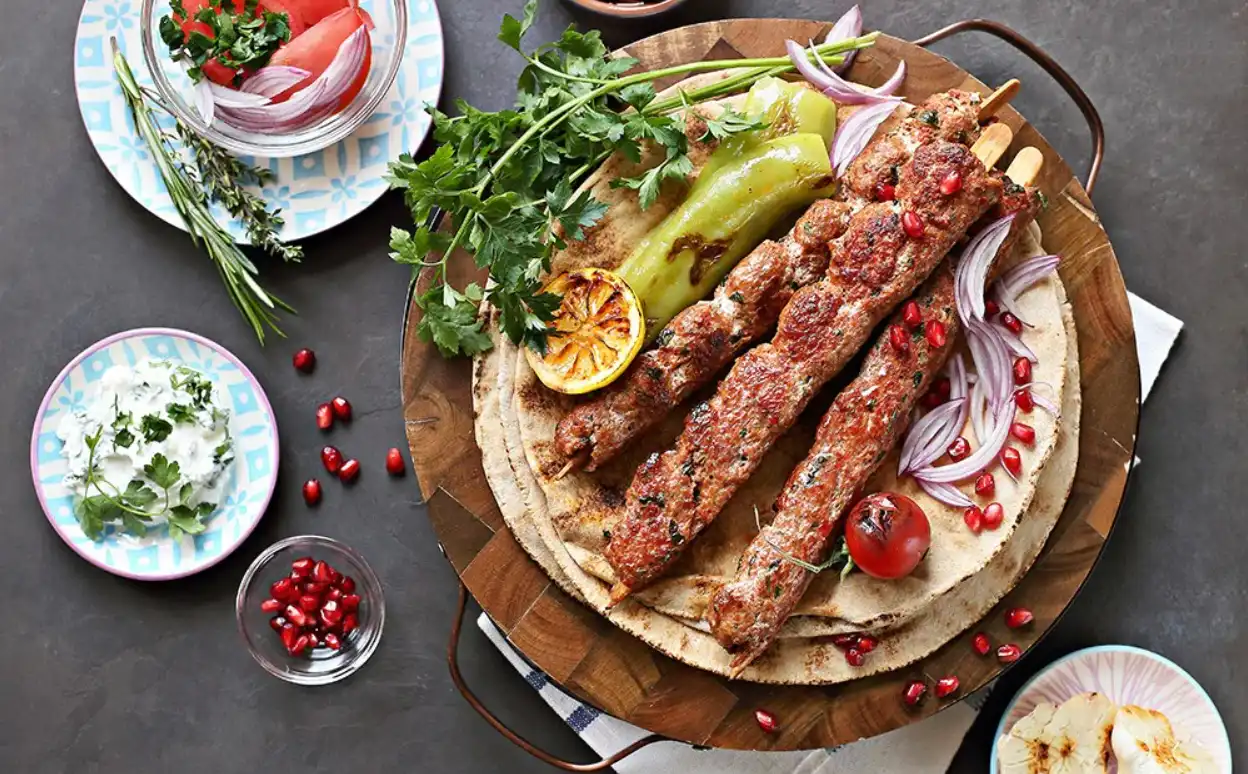
Meat plays an important role in the traditional Turkish kitchen. There are so many varieties of Kebabs prepared with lamb, beef, or chicken, mixed with vegetables and spices. the meat is cooked on a wood-fired kebab and then served on a plate, usually accompanied by braised tomatoes and peppers, rice or tomato bulgur. It can also be served in a sandwich or rolled in a wrap. There is a very wide variety of kebabs in Turkey, the most famous ones are:
Şiş Kebab
The most common variety of kebab is marinated lamb or beef cooked on a skewer called a "shish," or written in Turkish as şiş. Vegetables are sometimes cooked along with them, wherein typical vegetables include eggplant, tomato, bell pepper, onions, pickles and mushrooms.
Adana & Urfa Kebab
On any menu these will be listed as two different varieties, but theyre essentially the same except that Adana is a spicier version of the Urfa Kebab. Both kebabs are a mixture of ground beef and/or lamb thats kneaded together with onion, garlic and local spices before being packed by hand on a shish. These spices are the primary difference between Urfa and Adana kebabs, with Adana featuring red pepper flakes and urfa features paprika and other milder spices (like oregano and cumin) that still burst with flavor without being too hot. The dripping fat helps bind the meat together, so that after its cooked youll see a hole right through the middle of it.
Doner Kebab
Doner kebab is a type of typical meat dish, made of meat cooked on a vertical skewer. The meat is usually prepared as a mixture of lamb and beef, but in some case it can be just beef or just chicken. The marinated meat pieces are mixed with some minced meat and they're stacked on a tall vertical spit which is turning slowly next to a vertical wood or coal fire. As it gets grilled, the cooked outer part of the cone of meat is shaved in thin slices by a huge sword-like knife, and arranged on a plate with Ace or flat pide (pitta) bread. It can be served plain as is on a plate, or put on white rice, or rolled in a regular bread or lavash wrap.
Köfte
There are meatballs of lamb or beef or sometimes both, mixed with spices and onions. There is a wide variety of koftes but you should realy try şiş köfte and piyaz while you are in Antalya.
Piyaz
Piyaz is a traditional Turkish salad. In most of the country, it's a general term for a dish of dried beans, parsley, onions, and sumac. In Antalya, however, piyaz also contains a rich and smooth sauce consisting of tahini, lemon juice, and vinegar.
The beans are topped with the sauce, and the dish is usually dressed with chopped tomatoes, sliced onions, hard-boiled eggs, olive oil, and parsley. Piyaz is often eaten as an accompaniment to köfte and similar grilled meats, but it can also be included in a meze selection.
İç pilav
İç pilav is a flavorful Turkish pilaf made with a combination of rice (often of the Baldo variety), onions, currants, tomatoes, mint, and pine nuts. It is typically flavored with allspice, cinnamon, salt, and pepper. The ingredients are combined, and when the rice is cooked, the pilaf is ready to be stirred for one last time, then consumed. İç pilav is traditionally used as an accompaniment to roasted or fried meat dishes.
Other specialties to offer: "Lahmacun, Pide, Mantı"
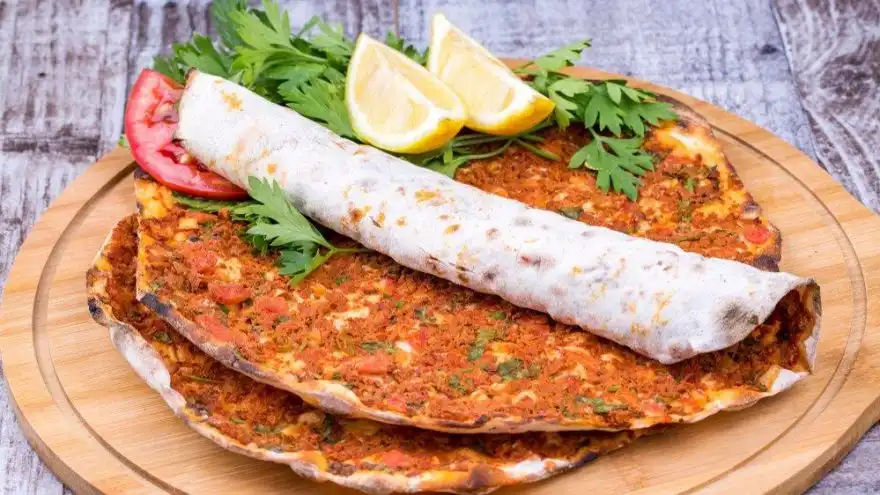
Lahmacun is a round, thin piece of dough topped with minced meat (most commonly beef or lamb), minced vegetables and herbs including onions, garlic, tomatoes, red peppers, and parsley, and spices such as chili pepper, paprika, and cinnamon, then baked.
Pide is a kind of wood-fired ''Turkish pizza'' It can be filled with either minced meat, cheese, spinach, pieces of meat, braised meat, beef sausage, pastrami and/or eggs.
Manti, which is also referred to as Turkish ravioli may vary in size and shape depending on the region from which it comes. They may be boiled, steamed, baked or fried, but the recipe itself is fairly standard. A classic pasta dough is rolled out and filled with a mince of either lamb or beef and onions and spices then folded and cooked. It is then served topped with a garlicky yogurt sauce and sprinkled with sumac, red pepper, oregano or mint.
Desserts You Have to Try: Kabak Tatlısı, Maraş Dondurma, Baklava, Künefe
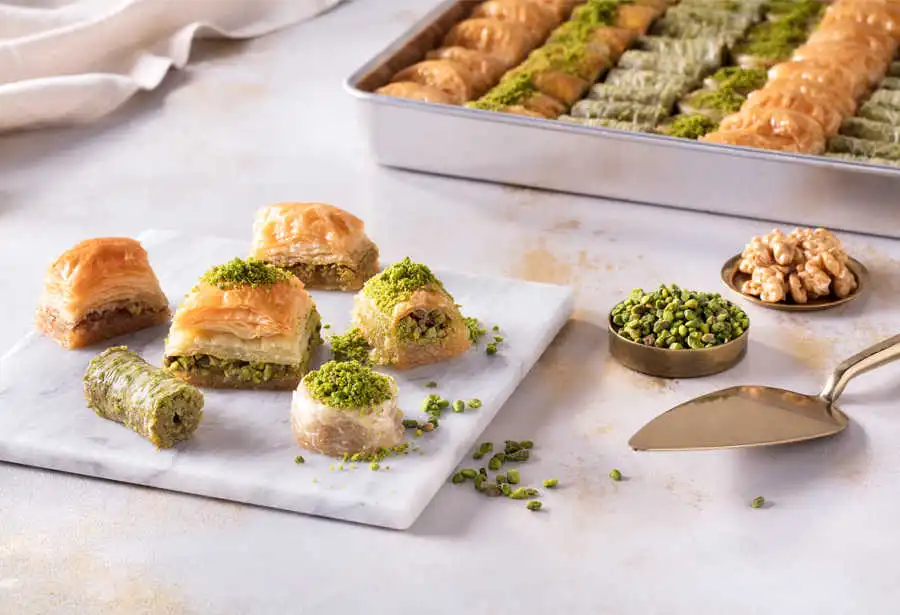
Fresh Pumpkin Dessert with Tahini
Kabak tatlısı is a popular Turkish dessert made from pumpkin that’s candied in a simple sugar syrup, and then garnished with lemon juice and walnuts.
Turkish Mastic Ice Cream: Maraş Dondurma
Turkish ice cream is believed to originate from the city of Maraş and what really sets it apart from other varieties is its resistance to melting and a particularly dense, chewy texture. These qualities are brought by adding two thickening agents to the basic milk and sugar mixture: Arab gum, also known as mastic resin, and salep—a type of flour made from the root of the early purple orchid. Maraş ice cream typically contains distinctly more salep than usual, which is why it is sometimes called kesme dondurma—from the Turkish kesmek, meaning to cut—which is the reason why this ice cream variety is usually eaten with a knife and fork.
Baklava
This dessert actually hails from Central Asia and spread from there throughout the Ottoman world. It eventually made its way to Europe, where the Viennese modified it as strudel. Today, the indisputable baklava capital is the city of Gaziantep, where the sweet stacks of fine filo pastry, drenched in milky honey and covered in pistachio nuts, are an art form.
Turkish Künefe
Künefe is a crispy cheese-filled dessert made with kadayıf, which is a traditional shredded wheat dessert with pistachio filling. Künefe is served hot out of the oven so the cheese is soft and stringy. Künefe is cooked and served in a very shallow, round metal pan that's specially designed for making this dessert. It's so delicious that Turkish people and tourists alike keep coming back for more.
Don't forget to try Türk Kahvesi & Çay
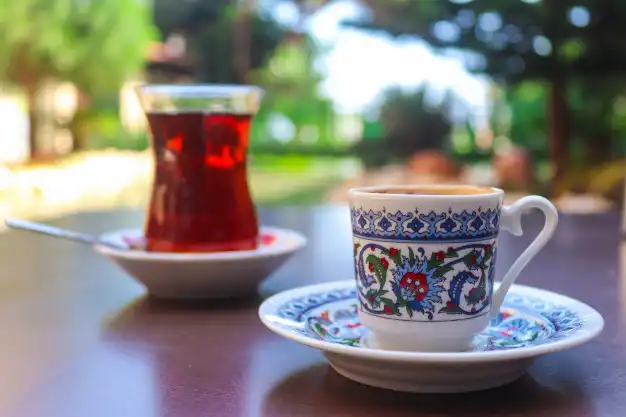
Turkish Coffee
Turkish coffee has become famous all around the world for both its strong taste and its special methods of preparation and service. Turkish coffee is a method, not a flavor, and it takes a truly skilled barista to keep the brew hot enough to cook each cup with a head of foam and fine grounds at the bottom. Once you’re finished, a good Turkish host will turn your cup upside down and study the grounds to divine your fortune.
Turkish Tea
Tea in Turkey is a real institution, it is a sign of hospitality. It is served when you visit people, and often offered at the end of a meal. Most of the time, it is black tea. It's drunk in a small glass. We drink it any time of the day.